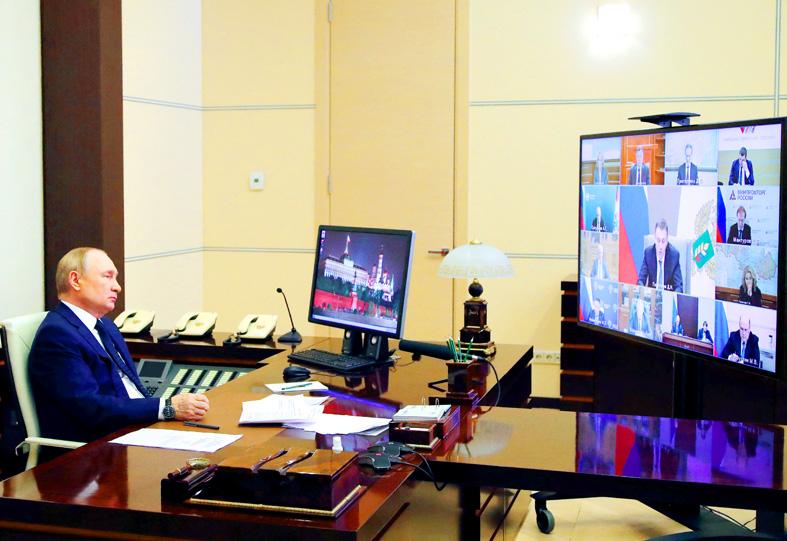Asian importers of Russian gas were yesterday scrambling after Russian President Vladimir Putin said that “unfriendly” countries must pay for Russian gas in rubles, in the latest jolt to global energy markets after Moscow’s invasion of Ukraine.
Taiwan, Japan and South Korea were on the list of countries deemed unfriendly. They all import liquefied natural gas (LNG) from the Sakhalin-2 and Yamal projects in eastern Russia.
Putin on Wednesday said that Russia would continue to supply gas in volumes and prices fixed in contracts, but would require payment in rubles.

Photo: AFP
In Taipei, the Ministry of Economic Affairs said that state-owned CPC Corp, Taiwan (CPC, 台灣中油) has one gas shipment arriving from Russia at the end of the month, adding it had received “no news that the payment system will be adjusted.”
Japan, the biggest importer of Russian LNG in Asia, said it had no idea how Russia would enforce that requirement.
“Currently, we’re looking into the situation with relevant ministries, as we don’t quite understand what [Russia’s] intention is and how they would do this,” Japanese Minister of Finance Shunichi Suzuki said in parliament.
Japan imported 6.84 million tonnes of LNG from Russia last year, Refinitiv trade flow data showed, making up nearly 9 percent of its LNG imports.
JERA, Japan’s biggest LNG buyer, has not received any notification from Sakhalin Energy, the joint venture that operates Sakhalin-2, to change the currency of payment from the US dollar, a company spokesperson said.
The spokesperson added that the country’s biggest power generator would keep gathering information.
A thermal power and fuel joint venture between Tokyo Electric Power Co Holdings and Chubu Electric Power Co, JERA buys about 2 million tonnes a year of LNG from the Sakhalin-2 project under long-term contracts, Japan Oil, Gas and Metals National Corp data showed.
Tokyo Gas Co and Osaka Gas Co, the country’s two biggest local gas suppliers, were also checking details on the ruble requirement, company spokespersons said yesterday.
Tokyo Gas, one of Japan’s largest LNG buyers, declined to comment on any details of its long-term contract for 1.1 million tonnes per year with Sakhalin Energy, including what currency it can use for payment.
Sakhalin Energy is 50 percent owned by Russia’s PJSC Gazprom, with Shell PLC holding a 27.5 percent stake while the rest is held by Japan’s trading companies Mitsui & Co and Mitsubishi Corp.
Shell on Feb. 28 said that it would quit the project, and the Japanese government has said Shell’s exit did not affect Japan’s energy imports.
Mitsui and Mitsubishi are checking details of Russia’s announcement, their spokesmen said.
South Korea, Asia’s third-largest importer of Russian LNG, expected to be able to continue imports, with the South Korean Financial Services Commission saying it would do whatever was necessary to facilitate trade.
Korea Gas Corp said it imports about 2 million tonnes per year of Russian LNG, making up about 6 percent of the company’s imports.
However, the company does not transact directly with Russia as its purchase contract is with Sakhalin Energy and payments for the gas go into a Japanese bank in Singapore, it added.
“Since we are making payments to that Japanese bank, we are not currently seeing issues now, but we are closely monitoring the development,” a Korea Gas official said.
The call for payments in rubles was seen as Putin’s way of trying to shore up the currency, which has collapsed after the imposition of sanctions on Russia.
Putin said the government and central bank had one week to come up with a solution on moving operations into rubles and that Gazprom would be ordered to make the corresponding changes to contracts.
The move is unlikely to work, said Eswar Prasad, a trade policy professor at Cornell University.
“Foreign importers would no doubt be happy to pay for their purchases of Russia’s exports in a currency that is collapsing in value, although getting access to rubles in a manner that does not fall afoul of sanctions could be tricky,” Prasad said.
Getting paid in rubles would do little to secure the hard currencies Russia needs to prop up its currency’s value in global markets or pay for imports from other countries, he added.

GROWING OWINGS: While Luxembourg and China swapped the top three spots, the US continued to be the largest exposure for Taiwan for the 41st consecutive quarter The US remained the largest debtor nation to Taiwan’s banking sector for the 41st consecutive quarter at the end of September, after local banks’ exposure to the US market rose more than 2 percent from three months earlier, the central bank said. Exposure to the US increased to US$198.896 billion, up US$4.026 billion, or 2.07 percent, from US$194.87 billion in the previous quarter, data released by the central bank showed on Friday. Of the increase, about US$1.4 billion came from banks’ investments in securitized products and interbank loans in the US, while another US$2.6 billion stemmed from trust assets, including mutual funds,

AI TALENT: No financial details were released about the deal, in which top Groq executives, including its CEO, would join Nvidia to help advance the technology Nvidia Corp has agreed to a licensing deal with artificial intelligence (AI) start-up Groq, furthering its investments in companies connected to the AI boom and gaining the right to add a new type of technology to its products. The world’s largest publicly traded company has paid for the right to use Groq’s technology and is to integrate its chip design into future products. Some of the start-up’s executives are leaving to join Nvidia to help with that effort, the companies said. Groq would continue as an independent company with a new chief executive, it said on Wednesday in a post on its Web

Even as the US is embarked on a bitter rivalry with China over the deployment of artificial intelligence (AI), Chinese technology is quietly making inroads into the US market. Despite considerable geopolitical tensions, Chinese open-source AI models are winning over a growing number of programmers and companies in the US. These are different from the closed generative AI models that have become household names — ChatGPT-maker OpenAI or Google’s Gemini — whose inner workings are fiercely protected. In contrast, “open” models offered by many Chinese rivals, from Alibaba (阿里巴巴) to DeepSeek (深度求索), allow programmers to customize parts of the software to suit their

JOINT EFFORTS: MediaTek would partner with Denso to develop custom chips to support the car-part specialist company’s driver-assist systems in an expanding market MediaTek Inc (聯發科), the world’s largest mobile phone chip designer, yesterday said it is working closely with Japan’s Denso Corp to build a custom automotive system-on-chip (SoC) solution tailored for advanced driver-assistance systems and cockpit systems, adding another customer to its new application-specific IC (ASIC) business. This effort merges Denso’s automotive-grade safety expertise and deep vehicle integration with MediaTek’s technologies cultivated through the development of Media- Tek’s Dimensity AX, leveraging efficient, high-performance SoCs and artificial intelligence (AI) capabilities to offer a scalable, production-ready platform for next-generation driver assistance, the company said in a statement yesterday. “Through this collaboration, we are bringing two